![]()
In Montgomery County, Ark. skunks, more white than black waddle down the gravel roads, white tailed deer, turkey hens and roadrunners run across the roads day and night, box turtles stop in the middle, coyotes and the little Bobwhite quail trot down the Hog Jaw roads. Wild turkey can be seen on the verges on the way to Mount Ida and down the forest service roads ready to fly into the pines and bald eagles swoop across out of dead trees - a magnificent site. Woodpeckers frequent the trees and butcher bird or scissor tail impaled grasshoppers on the barbed wire fences. Beavers slap their tail in Fiddlers and Brushy Creeks. Canoeing down the Ouachita River you might view mink, bobcats, snakes, fish (alligator gar) and birds of prey and swallowtail butterflies at Shirley Creek Recreational Area.
In June 2008 a big black bear was photographed behind Oden Lake and another adult black bear was seen up Brushy Road in June 2009. At night in June you might see fire flies, Luna moths during the clear incredible night skies with satellites and Iridium flares and skunks, armadillos digging and hear bull frogs, tree frogs and the barred owl hoot "Who cooks for you, who cooks for all". Thousands of species of animals and plants can be found in the Natural State.
In September 2010 a black bear with two young cubs was seen near a pond down Brushy Rd, Oden. The mother and cubs ran up a tree. The cubs were very agile and were seen running back and forth along the branches. Coyotes were coming very close to the chicken houses at night, found a dog killed by coyotes and a chook. Their shrill yips woke us each night and sound was real close to the house in the south field. It was not like that twenty years ago. While walking through the woods near Norman saw four armadillos during the day. Saw a one, an armadillos road kill, on Brushy road with a stunted tail.
The turtle is a three-toed box turtle Terrapene carolina triunguis. The Ouachita National Forest also has the Eastern box turtle which is similar. On the back legs, the three toed box turtle has three toes versus the four toes on the hind legs of the Eastern Box Turtle. During mid May to mid June many box turtles can been seen on the roads, when it is the mating season. Many get run over. Don't take them home for pets - another contributing factor to their mortality, and they smell when placed in the back seat!. A box turtle average life span is 25-30 years and it takes about 7-to 10 years before they start laying eggs. On any of the nature trails a variety of mushrooms bloom.
Toad eggs
Dwarf American Toad - Lake Ouachita S.P. - June 2010
Little wild violets, Manfred Rd, March 2008
What type of toadstool? Bight berries and bright toadstools are often poisonous.
What is it? Dec. 2008 A dried seed pod.
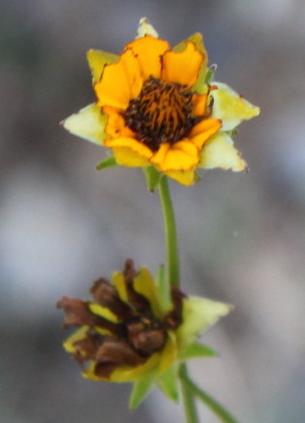
Beaver activity along Little Brushy Creek in 1995.
Beaver activity Oct. 2015, at pond down Brushy Rd. Saw three beaver. A large lodge.
May 2009. What type of bird built this nest? A crane
Same pond where we saw the kingfisher.
Blue belted kingfisher at pond down Brushy Rd, Oden, AR Dec. 2008
Fishing is good here. This is the same pond where we saw the kingfisher.
Summer 2010 - catch and release, a perch.
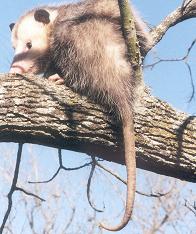
Their are many North American Opossums around the county. They often become road kill because of their slow ambulating gait. Possums are omnivores, meaning they will eat almost any kind of food with their 53 teeth especially persimmons. Possums will walk into a tent to look for food. Possums will hiss and snap or play dead to protect themselves and I have seen one walk in a 7 feet circle, to the right, for twenty minutes early one morning at a service station. Opossum hides fetched less than a dollar each during the 2007-2008 Arkansas harvest season. A captured wildlife by code is to be released alive and unharmed outside a municipalities boundaries within 24 hours. Traps must have the name an address, vehicle operator's license number or vehicle license number of the people setting them.
In a Nutshell.
Great snake,
Boy quake.
Horror froze
Garden hose.
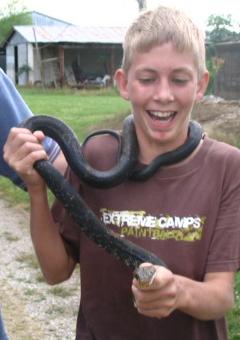
Redbud Acres, Brushy Road. May 2005. A 5 ft long harmless black king snake and an alligator gar.
Most snakes are harmless but a snake with a triangular shaped head is often poisonous. Copperheads, rattlesnakes, water moccasins and coral snakes (rare in these parts) are the only poisonous, indigenous ones in Arkansas. A common water snake has round pupils. When the weather starts to warm up snakes start to move. King snakes are about three to five feet long with salt and pepper coloring.Arkansas s-s-s-s-nakes By Tom Dillard Arkansas Democrat-Gazette September 6, 2009 Pages 84
I recently came across a small timber rattlesnake in my backyard, a reminder that living in the country amid towering hardwood trees does have a certain danger about it. Our ancestors certainly knew the dangers posed by poisonous snakes' and a whole lore has grown up around these reptiles.... Folklorists such as Vance Randolph and Otto Earnest Rayburn collected hundreds of stories about snakes, many of them fanciful if not outlandish. Randolph, in his 1951 book We Always Lie to Strangers, found that "nearly all old-timers believe that a certain kind of snake puts its tail in its mouth and rolls hoop fashion through the hills." In his 1941 book Ozark Country, Rayburn reported on a hoop snake attacking a woman, with the stinger barely touching her skirt. She washed her dress, and the poison "turned three tubs of wash water plumb green!" Interestingly, in none of the folk stories does the hoop snake actually sting a human-the victim usually being a tree. The tree usually dies quickly, often after swelling up considerably. Another bizarre folk belief involved snakes sucking milk from cows. Vance Randolph reports that he has "known sober, serious-minded adults to declare that they have actually seen big snakes milking cows in the pasture." Randolph is skeptical: "It seems to me that a snake's mouth, full of needlelike teeth pointing backward, would make milking difficult." When I was growing up in the rural Ouachita Mountains during the 1950s and 1960s, it was commonly believed that the coachwhip snake would chase people. Randolph reports that coachwhips were known not only to chase humans, it was especially prone to chase and actually whip truant boys. A large body of folktales deal with warding off snakes, as well as treating snake bites. Randolph says that many old timers believed there was something about the smell of gourds that repelled snakes, and many settlers grew gourds about their cabins. Tales of gigantic snakes dot the historical record. ... Arkansas does have a richness of snakes. In the 1950s, zoo directors from across the nation came to Grassy Lake in Hempstead County in southwest Arkansas to collect poisonous snakes. Marlin Perkins, who would later gain fame as the host of Mutual of Omaha's Wild Kingdom television series, was among the visitors who sought out specimens of copperheads, water moccasins, rattlesnakes, and coral snakes-the four poisonous snakes of north America. Forty-five species and subspecies of snakes are known to live in Arkansas. The largest venomous snake in Arkansas is the western diamondback rattlesnake. The most common of our venomous snakes is the copperhead-which is found in practically every county in the state. For me, the most frightening is the cottonmouth or water moccasin-which is not as retiring as most snakes, and will open its mouth to display the distinctive white interior.
Lake Ouachita - Canada geese and four goslings, 19 May 2009.
Note the water level is high
A beautiful old oak tree down Brushy Rd. Note were the cattle have been rubbing the lower branches. May 2005. 0800 in the morning.
Sunset. Redbud Acres. Nov. 2004.
Barn swallow nest May 2009, Brushy Rd, they will come back to the same place year after year. Swallows are rather common across Arkansas and Texas. They built nests under bridges, culverts and eaves of buildings. They build nests of caked mud and moss attached a wall or an object and is wide mouthed. Barn swallows are sleek birds with steel-blue backs and a forked tail. They fly on long, narrow pointed wings with shallow and slow wing beats.
Woodpecker hole, Dec. 2005. Branches broken from 2000 ice storm.
Is this a woodpecker hole? About three feet off the ground. Note tree is in a fence line.
The red spotted Purple not the Diana Fritillary butterfly which is the Arkansas state butterfly symbol. Photo June 2009, Brushy Rd, near a pond, Montgomery Co. AR More Arkansas butterflies. The female is black with dark blue markings. Plants and animals that are limited to a particular area are called endemics � and Arkansas is home to many such limited communities of plants, animals and insects.
The Pearl Crescent, common in the state. Oct. 2010.
????
Giant Swallowtail
Cloudless Sulphur, common in the state. Oct. 2010.
The Red Admiral, common in the state. Oct. 2010.
The common Buckeye. Oct. 2010.
The Hayhurst Scallopwing, uncommon statewide.
Checkered White on white clover. June 2010
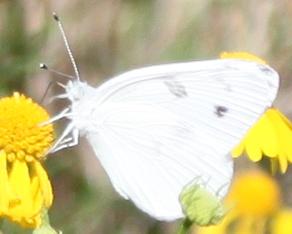
Checkered White on sneeze weed. June 2010What Love is Like
True love is like a butterfly;
It hovers low, it flutters high:
And once you catch it in your net
It's beauty you will ne'er forget.
True love is like a firefly bright,
It glitters best in darkest night.
In times of peace it burns the same -
Disaster fans it into flame.True love is like a budding rose,
It lends a fragrance as it grows,
The rose if plucked will soon decry,
Let love and roses have their way.
- Otto Ernest Rayburn
Arcadian Life Magazine, July-August, 1939, #41 page 37
Published in Caddo Gap, Arkansas - 15c a copy
This medium sized stream lined male lizard, the Prairie Racerunner, was in the water, down a well seeking a cool spot. The throat and belly are blue. June 2009, Brushy Rd. Hatchlings exhibit a blue tail that turns to brown with aging.
Prairie Lizard, gray, with a series of approximately 8 dark, jagged crossbars on the back, well camouflaged, found statewide.
A small, wiry Northern Rough Greensnake (Opheodrys aestivus), found statewide, also known as a Grass Snake. Oct. 2010
A young garter snake, Oct. 2010
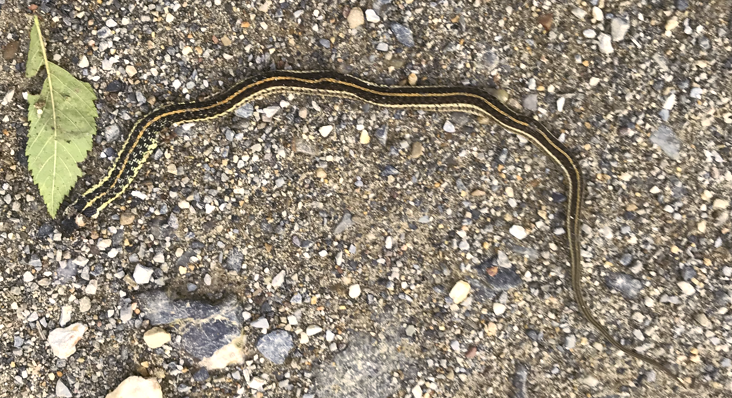
Sweet Home Rd 23rd Sept. 2023
Driving around Montgomery Co. in Oct. 2010, there were very few road kills. They were soon cleaned up by the turkey vultures. You often saw then circling overhead. Smelt a couple of skunks, walked passed a couple of small skeletons probably grass snakes and saw a dead butterfly and a whitetail deer dead on the side of the road. In May the roads are just covered with turtles trying to cross. In June saw a couple of dead squirrels and skunks and that is about it. The busier the road the fewer road kills. Amos
Privet growing wild in a fence line., Brushy Rd, Oden May 2009
Butterfly weed grows wild in a pasture down Brushy Rd. Cattle leave it alone.
Common milkweed and it's cousins, swamp milkweed, and butterfly weed, to name a few in the milkweed family, are crucial to the Monarch butterfly. Photo taken in the woods near Story 30 May 2015.
A White-tail hind near Story, 30 May 2015. Deer feed on forbs (any herb that is not a grass or grasslike.) Photos below taken on a hillside near Story 30 May 2015 within an acre. Adult deer have a reddish-brown coat in the summer months that they shed to a thicker brownish-grey winter coat. The deer feed on leaves, twigs and shoots from various shrubs, trees and vines e.g. honeysuckle. They prefer woodlands, brush lands, mixed Pine and Hardwoods.
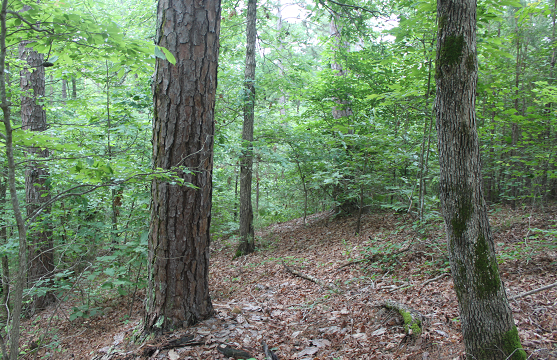
Pine (larger truck) and Hickory with the moss. The Ouachita are in a transition zone between two major forest associations: the Oak-Hickory forest (Ozarks) and the Oak-Pine forest (south). Caddo River bottomlands favor deciduous species including Oaks (White, Black, Post, Black-Jack, Red) and Hickory (Shagbark, Black, Mockernut, Pignut) Ash, Elms, Black; Sweet Gum, Maple, Ironwood, Lynnwood, Birch, Sycamore, are also found.Learning about mushrooms fast forward to 1:35:00 handouts. Most mushrooms do not have common names -Latin names. Fungi form one whole kingdom. First step find the genus. Look for species.
A reference guide: Mushrooms Demystified by David Aurora. online. Pictorial key - tabular key.
A field guide. Peterson. The National Society Field Guide to Mushroom. Can print key online
Take along: A camera and a Jovie - tripodstand, convertable pants, record location information, tuck pants into socks, (to avoid ticks), bug spray, (poison ivy antidote) tecnu. Observe combination of features. Mushroom shape differs. No stalk or growing on wood. Size of caps. Funnel shaped, gills, how they are attached, parasol shape, growing on trunk.Spore color does not change. Colour of cap changes a lot -wet, dry, young - old. Spore print. Take cap and place down on white paper or glass. Practice making a spore print. About 30 minutes spores fall -note colour of spores. Pink spores, black spores, white spores, light brown spores, dark brown spores.
Woodland mushrooms in Montgomery County, Arkansas. "Just view them from a distance, take photos, and look up information about them in books and on the Internet."
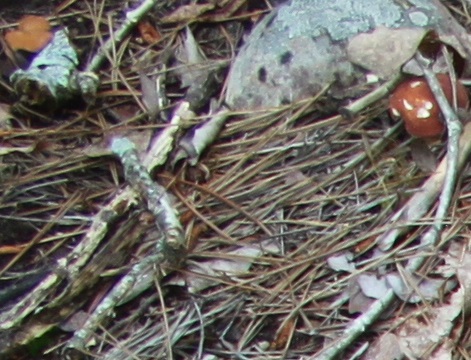
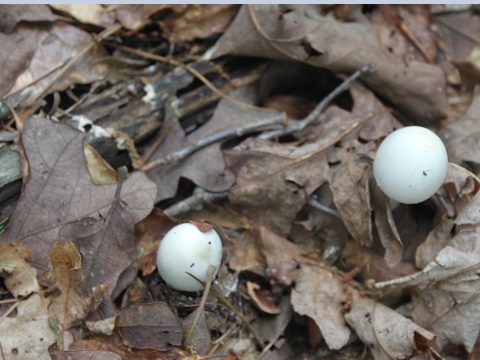
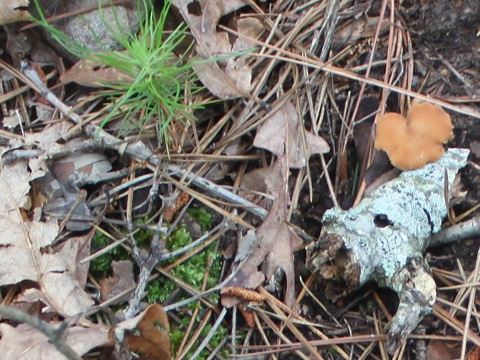
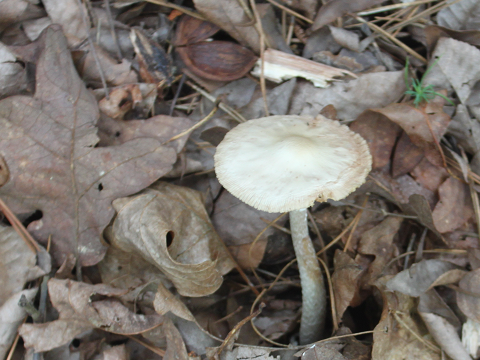
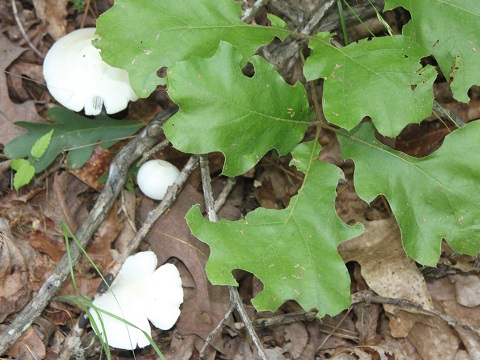
. Amanita bisporigira, aka the Destroying Angel. Leave it strictly alone. Deadly. Grows in woodland, leaf litter, mostly white, prominent cup at base, skirt that hangs down, white spore print and had free gills. Cap is smooth.
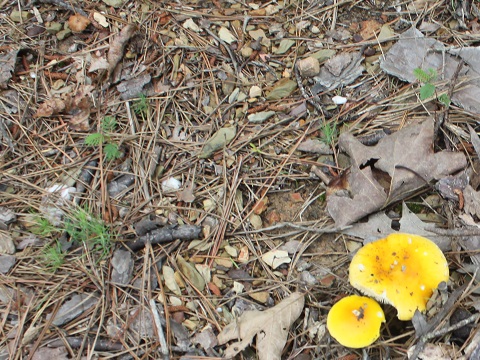
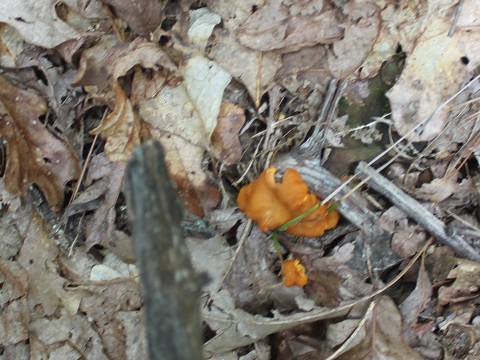
Hen of the Woods (Grifola frondosa), tend to grow on stumps, on bases on trees, note if growing on hardwood or conifer.
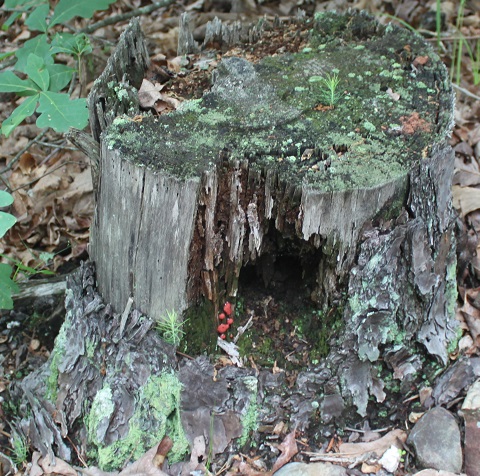
Carolina Buckthorn 13 Oct. 2019 taken at Oden.
Spring coming out of the ground, 30 May 2015.
Roundtop Mtn in background, Oden
How it was done.
Angler firm,
Little worm:
Silly fish,
Dainty dish.
Canada geese at Twin Creek, 2nd July 2017.
Deer- Joplin campground 29 June2017.
Twin Creek 2 July 2017. Cicadas have prominent eyes set wide apart, short antennae, and membranous front wings.
Moth at Twin Creek, 2nd July 2017. What type?Otto Earnest Rayburn was really taken with Caddo Gap, Norman, and other places in the Ouachitas but, he never quite stopped combining the Ouachitas in with the Ozarks! Arcadian Life was published in Caddo Gap for a while. In fact, issue 41 seems to have been published not long after Otto E. Rayburn arrived in Caddo Gap. He writes glowingly of the countryside: "I have discovered an Arcadian paradise where Nature greets the eye like a princess on parade." He also notes: "Dead must be the soul of the man who cannot thrill at the sight of these emerald mountains and silver streams!"
The Arkansas Historical Quarterly July 1, 1999
Otto Ernest Rayburn (1891-1960) spent virtually his entire adult life publishing magazines about the Ozarks region. He envisioned the Ozarks as an American Arcadia, with breathtaking scenery and a stalwart AngloSaxon culture, and published thousands of pages promoting its attractions. Gradually, however, it dawned upon him that the more people knew about his Arcadian paradise, the less like paradise it would be. Rayburn never made much money at publishing regional magazines. He persisted, however, for more than forty years and earned a place among the romantics, scholars, and promoters who, in the first half of the twentieth century, recorded the culture and lore of the southern mountains...Downy Serviceberry aka Sarvis, Service Berry, June Berry, Service tree, Shad bush, Wild plum, Sugarplum, Chuckley pear, Indian pear, Saskatoon, May cherry. A member of the rose family Amelanchier arborea. A small deciduous tree, usually much smaller than 50ft. Flowers are white petals, in drooping clusters appearing early before the leaves. Flowers are fragrant. The first large conspicuous white flowering tree to blossom in Arkansas forests. Fruitlike a tiny apple, sweet, edible, rounded, red to dark purple, ripens early June, eaten by birds and animals and probably by man since time of human habitation. Good fresh or in a pie. Smooth grey bark resembling that of the red maple. The leaves are are colourful in the fall - orange gold, red and green. A desirable ornamental tree, a good honey producer. Found throughout the state, fairly common on steep and stony hill slopes where it is associated with oaks and hickory. Reference: Trees of Arkansas by Dwight Moore, revised edition edited by Eric Sundell published by the Arkansas Forestry Commission, Little Rock. The 168 page book $5 from the Mt. Ida office just down the road from the ONF office, just east of Mt. Ida. Plant a root sucker in a pot, keep soil damp, second or third year it will take off.


In the field there is buttercups and crimson clover. Crimson clover, Trifolium incarnatum, a herbaceous legume introduced from Eurasia, it can be invasive and weedy. Found statewide. Blooms May to August. A cultivated species. Found in fields. open areas, pastures, meadows, roadsides. The seeds and flowers are edible. Seeds can be sprouted and used in salads or sandwiches. They can also be dried and ground into flour. Flower heads can be used fresh or dried as a tea. Crimson clover is gaining popularity as a introduced winter-killed annual, like oats, in Zones 5 and colder. Montgomery County, Arkansas is zone 5.The buttercup, Ranunculus spp. has bright yellow flowers, can bloom any time of the year but mainly in spring and summer. Found in wet to dry areas in fields and woodlands, statewide in all types of soil. The seeds are often eaten by turkey. Buttercup not bitterwwed
Natural Heritage by Tom Dillard, May 24, 2009 Editorial, Pages 88
Tom Dillard is head of the special collections department at the University of Arkansas in Fayetteville. Email him at tdillar@uark.edu.
In honor of this month being Arkansas Heritage Month, with the theme of celebrating the state's natural heritage, today's column features plants and animals that appear nowhere else but this state. Plants and animals that are limited to a particular area are called endemics-and Arkansas is home to many such limited communities of plants and animals. In 1995, biologist Henry W. Robison and entomologist Robert T. Allen published a 121-page book titled Only in Arkansas, which identified 117 species and subspecies of plants and animals that are believed to be endemic to Arkansas. The 106 animals include a large number of invertebrates-two worms, eight snails, three mussels, 21 crustaceans, and various crayfishes, and millipedes. Endemic insects number at least 30, including mayflies, stoneflies, and at least 10 beetles. Robison and Allen note that animal habitats do not follow state boundaries, so many species of limited presence in Arkansas are also found in neighboring states and thus are not endemic despite their limited range. Arkansas' interior highlands, the Ozarks and Ouachitas, have long been known to harbor small endemic populations of many plants and animals. Over millions of years these uplands might have been safe havens for species that suffered during various periods when much of the continent was not habitable.
Among the score or so beetles endemic to Arkansas is Scaphinotus parisiana, a large one discovered on Magazine Mountain in Logan County-an area rich in endemics and rare species. The species name, parisiana, honors Paris, the Logan county seat. Interestingly, this beetle feeds exclusively on escargot. The beetle has evolved a narrow head that allows it to push far into the shell and extract the snail.
Three mussels are endemic to Arkansas. The Arkansas Fatmucket mussel is found only in a few rivers in the Ouachita Mountains. The speckled pocketbook is found only along the upper Little Red in Stone and Van Buren counties. Many mussels are threatened or endangered.
Among the animals with the most limited distribution is a crayfish that lives in streams within Hell Creek Cave in Stone County. The 1,500-foot long limestone cave was home to the fewer than 50 such creatures reported by Robison and Allen in 1995. In reaction to its dark habitat, the crayfish lacks pigment, has a reduced body size, and small eyes.
Crayfish are also endemic to the lowlands, including a large and handsome burrowing species found in a single location in Union County. A species endemic to Howard and Pike counties is a colorful crayfish with some specimens sporting tan bodies and purplish pincers. This species builds multi-branched burrows in marshy areas. Colonies are usually small-four to nine burrows.
A number of vertebrate animals are endemic to Arkansas. At least five species of bony fishes are found only in the state; two are madtom catfishes and three are darters-all quite small. The Ouachita madtom is found in very small numbers in the Saline River basin. Another endemic Arkansas fish is the Caddo madtom, found only in Montgomery, Pike, and Polk counties in the upper reaches of the Caddo River. Two amphibian species are endemic to Arkansas, both being salamanders. The Caddo Mountain Salamander is found only in Montgomery, Polk, and Howard counties in the Ouachitas. The other endemic salamander is the Fourche mountain salamander, found in Polk and Scott counties-also in the Ouachitas. The sleek creature is distinguished by two rows of spots running its length.
In comparison to animals, only a few plants are endemic to the state. Perhaps the best known of these is Moore's delphinium. Discovered in 1935 by the dean of Arkansas botanists, Dwight M. Moore, this two-foottall delphinium sports beautiful sky blue flowers. It is found only in the Ozarks and Ouachitas. The maple-leafed oak is not only endemic to Arkansas-it is found only on Mount Magazine. It takes its name from its broad leaves which resemble those of the maple. Seldom reaching 20 feet, the maple-leafed oak is usually multi-trunked, and it produces very small acorns. Perhaps Arkansas' nickname as the natural state is more than a slogan.Natural Heritage - Tom Dillard May 17, 2009 Editorial, Pages 84 Publication: Arkansas Democrat-Gazette (Little Rock)
The topic this week is the natural heritage of Arkansans, which is in recognition of this year's Arkansas Heritage Month theme "Exploring Our Natural Heritage."
Thousands of species of animals and plants can be found in the Natural State. This column will focus on a few of the animals that once called Arkansas home.
Early explorers and settlers in Arkansas were unanimously impressed with the wildlife. De Soto, the Spaniard who led an expedition through Arkansas in 1541-42, was greeted by vast herds of deer, while bison and elk were also found in numbers. Black bears were so common-and universally hunted by settlers for their meat and oil-that Arkansas was known as The Bear State. Trappers and hunters periodically converged on Oil Trough, a city on the White River where bear oil was stored for shipment to New Orleans. Buffalos were relatively plentiful in colonial Arkansas. University of Arkansas zoologist John A. Sealander believed "the major buffalo herds in Arkansas were found in prairies, cane brakes and open woods in the Gulf Coastal Plain along major rivers such as the Red, Saline, Arkansas, and St. Francis . . . ." By the time Arkansas was acquired in the Louisiana Purchase of 1803, buffalo were already in rapid decline. The last large herd, about 150 animals, was killed in the Saline River bottoms in 1808. German traveler Frederick Gerstaecker reported a few remaining buffalos in the Cache River bottoms in 1837. Early settlers reported many wolves in Arkansas. They were systematically hunted. Gerstaecker wrote of several wolf encounters, including one occasion when he unsuccessfully pursued a large black wolf with a white patch on his chest. Gerstaecker regretted his failure, for as he noted, "a wolf's scalp is valued at three dollars in Arkansas." By 1910 wolf sightings were rare enough to be mentioned in local newspapers. Among the animals that no longer live here due to extinction are two birds whose vast numbers awed early Arkansans, the passenger pigeon and the Carolina parakeet. ...Natural heritage
By Tom Dillard
May is Arkansas Heritage Month, and this year's theme is "Exploring our Natural Heritage." While our nickname as the Natural State might be challenged occasionally with good reason, Arkansas remains a natural wonder.
This article was published May 10, 2009
Editorial, Pages 82 on 05/10/2009
1928: Here only a few years ago roamed great numbers of deer and turkey; here also were many bears and foxes, and a little further to the east of the Ouachita River there were beaver. Quail also raccoon and 'possum may be found along water courses. The streams abound with fish. A great variety of forest trees and wildflowers. On the heights may be found cedar, mountain laurel, rhododendron, locust, cucumber (magnolia acuminata) hickory, red and white oak. Lower down, the pin oak, blackjack oak, chinquapin, elm and beech. Along the water courses, cottonwood, sycamore, water oak, gum and dog wood.
Arkansas' natural heritage is as diverse and interesting as its cultural history.
- Turtle Crossing
- Birding Opportunities
- AR Game & Fish Commission brochures
- The Lake Ouachita Nursery Pond
- Picturesque Ouachita faces big future - Arkansas Democrat p.8+ Dec 4, 1960
- Arkansan once served in Royal Air Corps - Arkansas Democrat Magazine p.2 Sept 22, 1963 Reed Landis likes living on shore of Lake Ouachita: Brady Mountain Lodge
- Dream fishing comes true in development under way at man-made Lake Ouachita by Reed G. Landis, Arkansas Gazette p.2F Aug 7, 1955
- Montgomery--a paradise for the lovers of nature - Arkansas Gazette p.F (?) Mar 15, 1953
- The scales of justice by Jim Spencer. Early turkey hunting. Arkansas Game and Fish 20(3):23 May ; June 1989. Illustration il Location Pencil Bluff
- Of mules and men: hunting in style in Montgomery County by Jim Spencer, Arkansas Game and Fish 15(2):2-5 May/June 1984
- Mount Ida finds "New Gold" in nearby lake. Arkansas Gazette p.1E July 12, 1959 [Fishing]
New youth camp planned on Lake Ouachita, Arkansas Gazette p.1E Oct 16, 1960
Caddo Gap is a break in a great blue hogback looming on the right from Glenwood on Sate 27.
Census 1880 - Tenth 1st June 1880.
The surface of the county is sparsely populated with an average of nearly 7 persons per square mile. The crops are corn, cotton, wheat, oats and potatoes, the first names having the largest acreage. Cotton comprises 17.9 per cent of the lands in cultivation, and the averages but 4.2 acres per square mile. The product per acre is less than half that of the state at large.
There are areas of metamorphic rocks in the county comprising chloritic slates, etc. The fertile portion of the county is said to be Caddo Cove, on the southwest, where much limestone appears.
Abstract G. Whittington, Montgomery County, March 23, 1880.
The lowlands consist of ten first bottom lands of South Fork creek and the Ouachita river. The uplands are rolling and the level table-lands well timbered. The lands devoted to the cultivation of cotton are the mahogany uplands, mostly level, the black loam of the south fork of the Ouachita, and the light upland timbered lands. The most important is the mahogany or hickory upland, extending in each direction about 25 miles, and having natural timber growth of pine, hickory, red oak, ash, walnut, dogwood and sassafras. The soil is a silty and gravelly loam, clayey in places, varying in colour from brown or mahogany to blackish or black and is 18 inches in depth. The subsoil is heavier than the soil. The soil is cultivated with difficulty in all seasons, is early and warm, and is best adapted to corn and wheat. The chief crops of the region are cotton, corn, wheat and oats. One tenth of the tillable land area is devoted to cotton, which grows to a height of 4 feet and runs to weed on all lands of the county under cultivation 9unmanured) for twenty years, is 1,000 pounds of seed-cotton per acre. Fourteen hundred and twenty five pounds are required, either from fresh or old lands, for 475 pounds of good ordinary lint. Crab-grass and cocklebur are the most troublesome weeds on all lands of the county. None of the land lies "turned out." Cotton is badly injured by early frosts after a wet, late season, especially in the rich bottom lands. Cotton is shipped to Hot Springs, and thence by rail to market.
Cotton production: 1,819 bales, average cotton per acre, 0.52 bale, 780 pounds seed-cotton, 0r260 pounds lint.
The Ouachita river bottom lands extend east and west about 20 miles, and have a natural timber growth of water, overcap , and bur oaks, walnut, elm, ash and mulberry.
The light-timber upland and the second-bottom lands have a natural growth of white and post oaks, elm, and sweet gum.
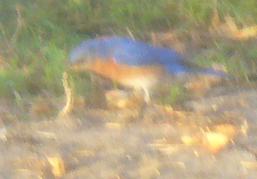
Early one morning Brushy Rd, Montgomery Co. AR. A pretty
Eastern Blue Bird with an orange breast. Taken through a window screen.